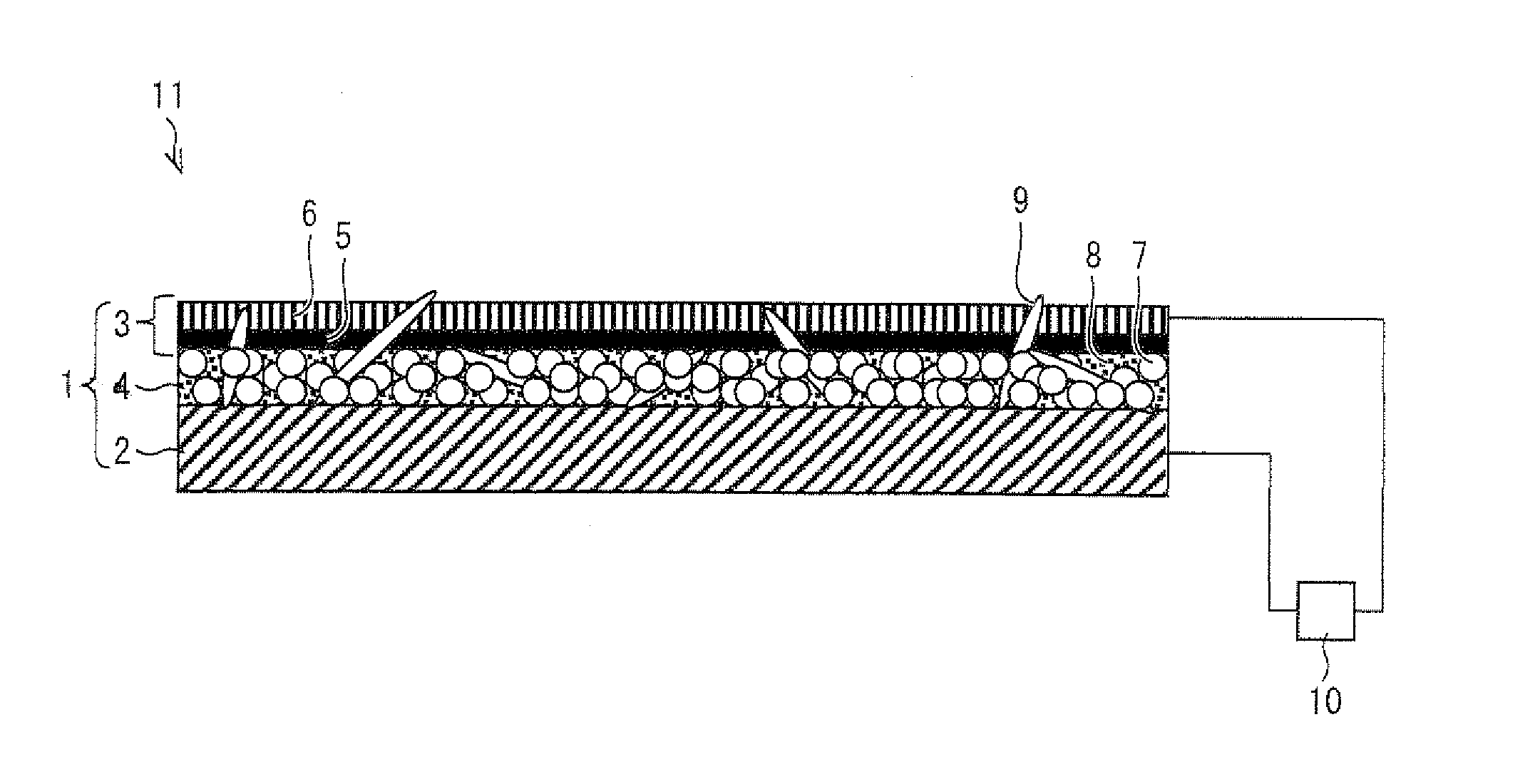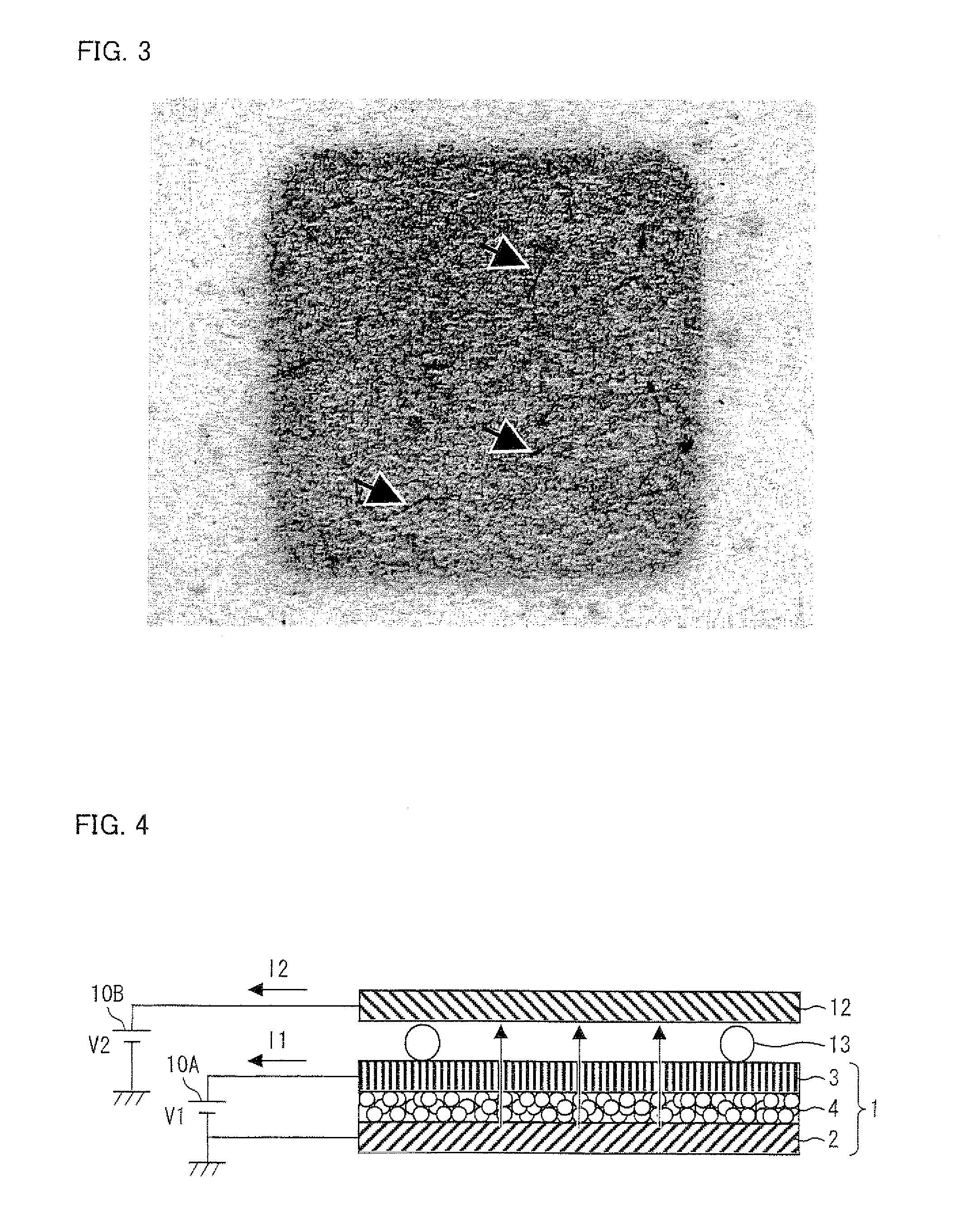Electron emitting element, method for producing electron emitting element, electron emitting device, charging device, image forming apparatus, electron-beam curing device, light emitting device, image display device, air blowing device, and cooling device
a technology electron beam, which is applied in the field of electron emitting element, can solve the problems of oxidizing various substances, breaking down the element, and ozone being harmful to human bodies, and achieves the effects of reducing power consumption, efficient electron emission, and prolonging the life of the electron emitting elemen
- Summary
- Abstract
- Description
- Claims
- Application Information
AI Technical Summary
Benefits of technology
Problems solved by technology
Method used
Image
Examples
embodiment 1
(Arrangements of Electron Emitting Element and Electron Emitting Device)
[0043]FIG. 1 is a view schematically illustrating an arrangement of an electron emitting device 11 employing an electron emitting element 1 in accordance with one embodiment of the present invention. The electron emitting device 11 includes the electron emitting element 1 of the embodiment of the present invention, and a power supply 10 (see FIG. 1). The electron emitting element 1 includes an electrode substrate 2 serving as a lower electrode, a thin-film electrode 3 serving as an upper electrode, and an electron acceleration layer 4 sandwiched between the electrode substrate 2 and the thin-film electrode 3. Further, the electrode substrate 2 and the thin-film electrode 3 are connected to the power supply (power supply section) 10, so that a voltage can be applied between the electrode substrate 2 and the thin-film electrode 3 which are provided so as to face each other. The electron emitting element 1 applies ...
example
[0078]In the following Example, first, the descriptions deal with a result of an experiment for finding (i) how the current in the electron emitting element 1 changes as the amount of the crystalline electron transport agent 9 to be added is changed, and (ii) how the amount of emitted electrons changes as the amount of the crystalline electron transport agent 9 to be added is changed, in a case where the crystalline electron transport agent 9 is in an amorphous state in the electron acceleration layer 4 (the crystalline electron transport agent 9 has not been crystallized). Secondly, the descriptions deal with a result of measurement of (i) the current in the electron emitting element 1 and (ii) the amount of emitted electrons, which measurement was carried out for each of (i) the electron emitting element 1 in which the crystalline electron transport agent 9 was in the amorphous state, and (ii) the electron emitting element 1 in which the crystalline electron transport agent 9 had ...
embodiment 2
[0097]FIG. 14 shows an example of a charging device 90 of the present invention, including an electron emitting device 11 employing an electron emitting element 1 in accordance with an embodiment of the present invention, which electron emitting element 1 is described in Embodiment 1.
[0098]The charging device 90 includes the electron emitting device 11 including the electron emitting element and a power supply 10 for applying a voltage to the electron emitting element 1. The charging device90 is used for electrically charging a photoreceptor drum 14. An image forming apparatus of the present invention includes the charging device 90.
[0099]In the image forming apparatus of the present invention, the electron emitting element 1 in the charging device 90 is provided so as to face the photoreceptor drum 14 to be charged. Application of a voltage causes the electron emitting element 1 to emit electrons so that the photoreceptor drum 14 is electrically charged. In the image forming appara...
PUM
 Login to View More
Login to View More Abstract
Description
Claims
Application Information
 Login to View More
Login to View More - R&D
- Intellectual Property
- Life Sciences
- Materials
- Tech Scout
- Unparalleled Data Quality
- Higher Quality Content
- 60% Fewer Hallucinations
Browse by: Latest US Patents, China's latest patents, Technical Efficacy Thesaurus, Application Domain, Technology Topic, Popular Technical Reports.
© 2025 PatSnap. All rights reserved.Legal|Privacy policy|Modern Slavery Act Transparency Statement|Sitemap|About US| Contact US: help@patsnap.com



